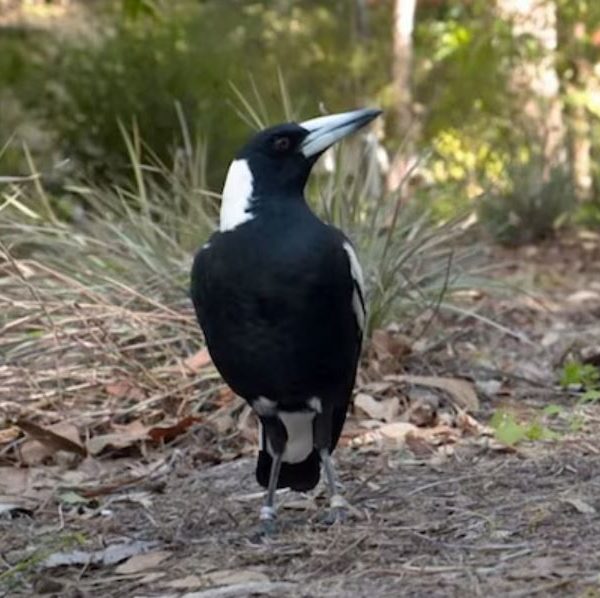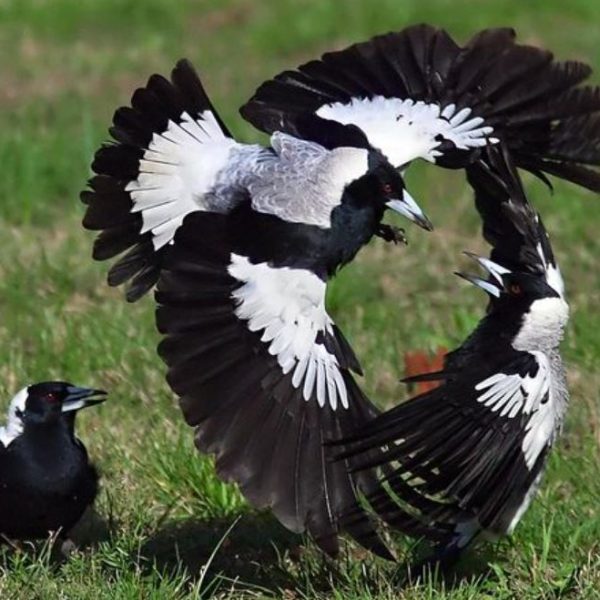The Australian Magpie (Gymnorhina tibicen) is a prominent and highly recognisable bird species, renowned for its striking appearance and melodic song. Birdwatchers visiting Murphys Creek Escape in South East Queensland have a great opportunity to observe and appreciate these birds in their natural habitat. Who doesn’t love a good magpie and you don’t necessarily need to come camping to see a magpie, however you will most likely see some while camping at Murphys Creek Escape. So if you are spending your weekend bird watching then don’t be disappointed you will be able to get some great photos.

Description and Physical Characteristics
- Size: The Australian Magpie is a medium to large-sized bird, typically around 37 to 43 cm in length.
- Coloration: It has a black and white plumage. The head, neck, and upper parts are predominantly black with white patches on the shoulders, belly, and wings.
- Beak: Features a robust, wedge-shaped beak suitable for their varied diet.
Habitat and Distribution
- Geographical Range: Common throughout Australia, especially in regions like South East Queensland where Murphys Creek Escape is located.
- Habitat: Adapts well to a variety of environments including urban areas, parks, and open country.
Behavior and Diet
- Diet: Omnivorous, feeding on invertebrates, small vertebrates, and various plant materials.
- Social Behavior: Australian Magpies are known for their complex social structure and can be found in groups or ‘magpie communities’.
- Territorial Nature: Particularly during the breeding season, they may defend their territories aggressively, sometimes swooping on intruders, including humans.
Vocalization
- Song: Renowned for their melodious and varied song, which includes a range of calls, mimics, and even human-made sounds.
- Communication: Their vocalizations are crucial for maintaining social bonds and territorial defense.

Breeding
- Breeding Season: Generally between August and October, but can vary based on geographical location.
- Nesting: The nest is a domed structure made of sticks and grass, usually placed high in a tree.
- Eggs and Incubation: The female typically lays 3 to 5 eggs, with the male often assisting in feeding the chicks.
Conservation Status
- Current Status: The Australian Magpie is common and widespread, not currently considered at risk.
- Adaptability: Remarkably adaptable to changing environments, including urbanization.
Observing Australian Magpies at Murphys Creek Escape
- Best Time to Observe: Early mornings or late afternoons, when they are most active.
- Where to Find: Look around open areas, near water sources, and where trees are plentiful.
- Observational Tips: Approach gently to avoid disturbing them, especially during breeding season when they can be protective of their territory.
The Australian Magpie, with its iconic appearance and melodious voice, adds a special charm to the experience of camping and bird watching at Murphys Creek Escape. Observing these birds in their natural setting offers a delightful insight into one of Australia’s most familiar and loved avian species.

Jared Jeffery, the digital marketing specialist at Murphys Creek Escape, is a seasoned professional in the field of SEO-driven marketing. With over 10+ years of experience, he possesses a well-rounded background in the digital realm. Throughout his career, Jared has worked in agencies specializing in Travel, Finance, and Event Planning, lending his expertise to major projects involving prominent hotel chains. In addition, he has contributed his writing skills to the creation of numerous articles spanning across a wide range of industries. With his wealth of knowledge and extensive experience, Jared brings a valuable skill set to the table.
